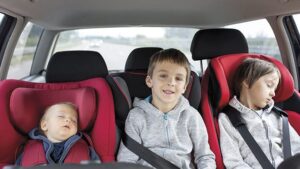When Children’s of Alabama launched the Alabama chapter of SAFE Kids in 1989, there were no child passenger restraint nor seat belt laws of any kind in the state. Now, 30 years later, a lot has changed to make the state’s roads safer for children and their families.
Alabama was one of the first states in the nation to establish a statewide SAFE Kids coalition. Since the chapter’s founding, Children’s and its SAFE Kids Alabama partners have led an ongoing campaign that includes education, legislation, environmental modification and technologic application. The coalition also tracks epidemiologic data to guide and evaluate intervention strategies.
Children’s, under the leadership of then-CEO Dr. Jim Dearth, supported the development of SAFE Kids Alabama with Dr. Bill King as its first director. The purpose of SAFE Kids Alabama was to build a statewide, grassroots coalition and to encourage corporate and private participation in preventing unintentional injury in Alabama children.
“It’s one of those things that people may take for granted, but this state is truly safer for children and drivers of all ages today than it was 30 years ago,” says King, now retired from Children’s and a Professor Emeritus at UAB. “A lot of hard work by a lot of people and agencies from all across the state, including bipartisan political efforts, was necessary. Our numbers of severe injuries and deaths in children are much better than where we were.
“Improvement in usage rates of car seats and seat belts are particularly noteworthy,” King continues. “Of course, there are always important, new challenges for us to address, like teen driver and passenger safety.”
While the state is statistically safer, motor vehicle crashes remain the leading cause of death and disability for children in Alabama as well as nationwide.
Accomplishments since the chapter’s founding in 1989 include:
- According to the Alabama Department of Public Health, overall child passenger safety usage has increased from less than 10 percent in 1981 to more than 96 percent today.
- The following laws have been passed in Alabama:
- 1982 – State passes law requiring children through age 3 to be transported in child passenger safety seats.
- 1991 – State passes its first seatbelt law, making not wearing a seatbelt while being in the front seat a secondary violation.
- 1994 – Law passes stating that children younger than 8 years of age must wear a properly secured U.S. Coast Guard personal flotation device (PFD) at all times while onboard any boat, except when in an enclosed cabin.
- 1995 – Bicycle helmet law passes, requiring everyone under the age of 16 to wear a helmet when riding a bicycle.
- 1999 – The existing secondary seatbelt law is made a primary offense.
- 2002 – First Graduated Driver’s License (GDL) passes, requiring new drivers achieve stages of advancement before unrestricted teen driving, generally limiting late-night driving and the number of passengers under age 21.
- 2006 – Car seat law amended to include booster seats.
- 2010 – GDL amended with numerous restrictions, including use of any handheld communication device.
- 2015 – GDL amended to require additional supervised driving time and reduced nighttime driving.
- 2017 – GDL amended to allow for primary enforcement.
Marie Crew, director of SAFE Kids Alabama, pointed to several Children’s-led initiatives involving pedestrian safety, bicycle and ATV safety, and distracted driving as examples of raising awareness.
“Our immediate focus is on helping raise safety awareness among teens and their parents,” Crew says. “As the old saying goes, ‘An ounce of prevention is worth a pound of cure.’ We want to do everything we can to help parents model safe driving behaviors and to initiate what can be uncomfortable conversations with their children about the risks associated with the responsibility of driving.”





